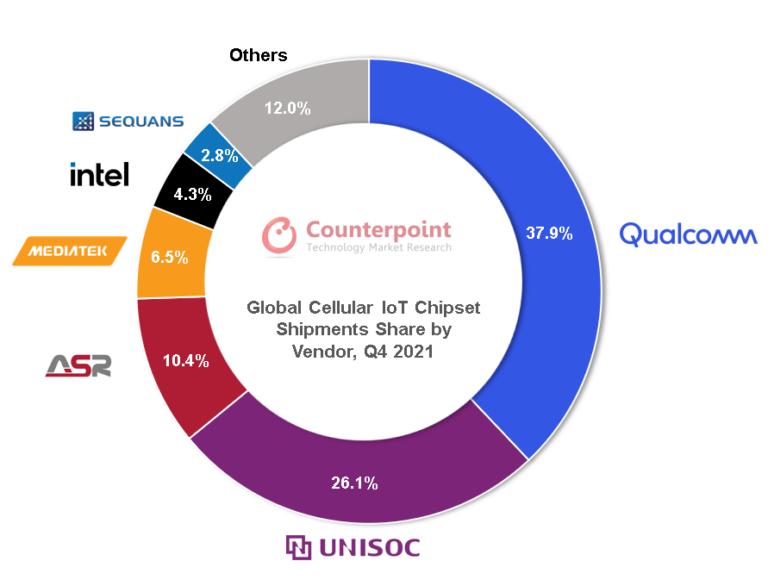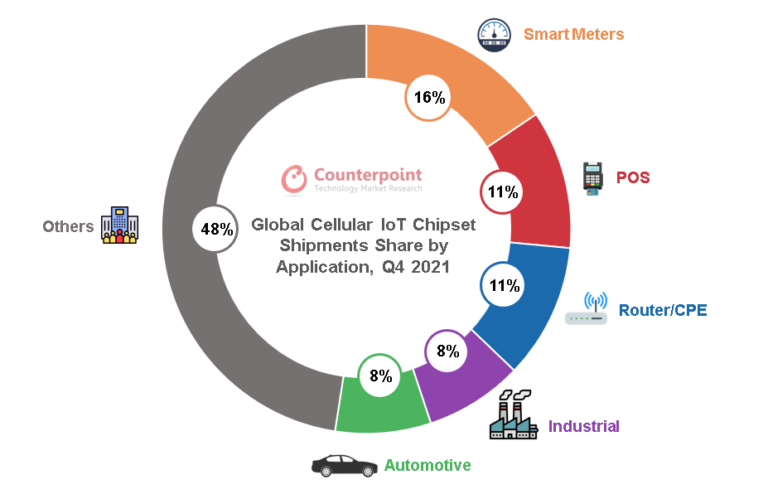How does the Chinese IoT chip maker surpass Intel and catch up with Qualcomm?
Not only is China consuming the majority of the total mobile IoT chipsets sold in the market, but its IoT chipset manufacturers are outpacing the world’s veteran manufacturers.
According to the latest Counterpoint report, in the fourth quarter of 2021, the number of mobile IoT chipsets shipped globally increased by 57% year-on-year.
In particular, China continues to dominate the market when accounting for nearly 60% of shipments. Manufacturers of the country of billions of people, such as UNISOC and ASR, are becoming formidable rivals of names such as Qualcomm, Intel, and MediaTek.
Mobile IoT chipsets are often integrated in products such as smart watches, routers, cars, and industrial equipment.

Global mobile IoT chipset market share. (Source: Counterpoint)
On a global scale, Qualcomm still leads with 38% market share in terms of shipments, followed by UNISOC and ASR. Together these three manufacturers account for 75% of total global mobile IoT chipset production. However, in China, domestic manufacturers have stepped up, causing Qualcomm to cede the No. 1 position to UNISOC to rank second, ASR ranked 3rd.
Excluding the Chinese market, Qualcomm is leading, followed by UNISOC and Intel.
Thus, it is clear that the high demand in the Chinese market and the preference for domestic products have created great opportunities for manufacturers such as UNISOC and ASR, but on a global scale, UNISOC also has the most influence. determined.
Among mobile IoT chipsets, 5G connected products saw the strongest growth, up 392% year-on-year. The 5G chipset application devices are mainly routers, computers and industries. Growth was followed by chipsets serving 4G Cat 1, with a 154% year-over-year increase.
Qualcomm is on track to gain market share, driven by growing demand in key segments such as automotive, routers, retail, and industrial IoT. But competition from local players in China, such as UNISOC and ASR, in 4G-related segments has limited Qualcomm’s growth opportunities in the world’s largest IoT market.
In response, Qualcomm expanded its portfolio of IoT solutions, targeting industries such as retail, automotive, industrial IoT, and smart cities. The company has launched a suite of IoT services including more than 30 products to build an ecosystem, bring more value to partners, and increase competition.
UNISOC, the second largest mobile IoT chipset company globally, has been developing strongly on NB-IoT and 4G Cat 1 technologies – both new technologies developed on the 4G platform. The market share of this company has continuously increased in the past 4 quarters. Moreover, it is jumping into more advanced technologies such as 5G, 4G Cat 4 and above. UNISOC’s market share increased partly thanks to large domestic customers such as Quectel, Fibocom, China Mobile,…
ASR Microelectronics maintained its third rank in the mobile IoT chipset market in Q4 2021 by exploiting the 4G gap left by UNISOC. ASR also has some major customers in the continent such as Quectel, Longsung and Rinlink.

Mobile IoT chipset division by industry. (Source: Counterpoint)
MediaTek occupies the fourth position in the market in Q4 2021. However, it does not focus as much on the mobile IoT market compared to the smartphone chipset market. This is one of the main reasons why they continued to lose 4% market share this quarter.
The leading sectors using mobile IoT chipsets are: smart meters, cash registers (POS), industrial, and automotive.
at Blogtuan.info – Source: genk.vn – Read the original article here


